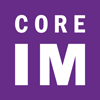Core IM
Atrial fibrillation is often diagnosed during inpatient hospitalizations, particularly in the setting of a recent surgery or acute illness such as sepsis. Despite how commonly it is encountered, new-onset atrial fibrillation has lacked clear guidelines or consensus on management. This has led to divergent practice patterns regarding the appropriateness and timing of anticoagulation and how patients are counseled on the risk of stroke associated with this diagnosis. Recently, a growing body of literature and new guidelines have created a clearer picture regarding long-term risk associated with new-onset atrial fibrillation. Join Core IM as they explore why these changes have not yet widely been adopted by inpatient physicians in the episode: Gray Matters: Atrial Fibrillation of Acute Illness.
First, listen to the podcast. After listening, ACP members can take the CME/MOC quiz for free.
CME/MOC:
Up to 1
AMA PRA Category 1 Credits ™ and MOC Points
Expires January 16, 2026
expires-soon
Cost:
Free to Members
Format:
Podcasts and Audio Content
Product:
Core IM
Welcome to Core IM, a virtual medical community! Core IM strives to empower its colleagues of all levels and backgrounds with clinically applicable information as well as inspire curiosity and critical thinking. Core IM promotes its mission through podcasts and other multimodal dialogues. ACP has teamed up with Core IM to offer continuing medical education, available exclusively to ACP members by completing the CME/MOC quiz.

Diagnosis and Duration of Atrial Fibrillation
- The diagnosis of atrial fibrillation is made by a 12-lead electrocardiogram or at least 30 seconds of atrial fibrillation on telemetry
- Longer durations of atrial fibrillation episodes have been associated with an increased thrombotic risk in stable outpatients with long term cardiac monitors1. This can be an additional objective factor in addition to the CHA2DS-VASc, however this is not currently reflected in any guidelines.
|
Longest Duration of Atrial Fibrillation episode |
Annual rate of stroke or systemic embolism |
|
≤0.86 hours
|
1.23 (95% CI, 0.15 to 4.46 |
|
0.87 to 3.63 hours
|
0 (95% CI, 0 to 2.08) |
|
3.64 to 17.72 hours
|
1.18 (95% CI, 0.14 to 4.28) |
|
>17.72 hours |
4.89 (95% CI, 1.96 to 10.07)
|
- The association between the frequency of atrial fibrillation episodes and thrombotic risk is less certain.
Long and Short Term Outcomes of Atrial Fibrillation Following Non-Cardiac Surgery or Acute Illness
- Should we think of patients who develop afib after acute illness or non-cardiac surgery differently from those who have pre-existing atrial fibrillation in the community?
- Atrial fibrillation diagnosed after sepsis2 or non-cardiac surgery3 confers an elevated risk of long term recurrent atrial fibrillation and thromboembolism
- Does putting patients with afib after critical illness or non-cardiac surgery help?
- The relative risk reduction of anticoagulation for thrombo-embolic stroke is similar between patients with atrial fibrillation diagnosed after non-cardiac surgery and those with pre-existing atrial fibrillation
- Why is atrial fibrillation after cardiac surgery thought of differently?
- Due to direct cardiac manipulation, atrial fibrillation following cardiac surgery is common and often resolves with cardiac healing. It is distinct from atrial fibrillation following non-cardiac surgery and warrants cardiac consultation to determine the optimal management
- Is there increased risk of stroke in the hospital or short-term in general? Is there increased bleeding risk?
- Atrial fibrillation diagnosed after non-cardiac surgery carries an increased risk of 30 day or in-hospital ischemic stroke7
- For those with newly diagnosed atrial fibrillation during severe sepsis, thromboembolic stroke risk is likely higher during the sepsis episode than for those with pre-existing or no atrial fibrillation5.
- However, anticoagulation during sepsis did not reduce this risk and did increase clinically significant bleeding risk6
Timing of Postoperative Anticoagulation
- Surgical considerations that may delay initiation of anticoagulation postoperatively include more extensive surgeries, trauma patients, and surgeries in confined areas where hematoma formation may be catastrophic (cranial, spinal, cardiac surgeries).
- The PAUSE trial supports resumption of DOACs 1 day after a low-bleeding risk procedure and 2-3 days after a higher risk intervention, provided hemostasis is achieved.8
- CHEST 2022 guidelines support
- Resuming warfarin 12-24 hours after surgery
- For DOACs, enoxaparin, or bridging anticoagulation with IV UFH
- For low to moderate bleeding risk surgeries: 24 hours post-op
- For high bleeding risk surgeries: 48-72 hours.9
- Which surgeries are considered high bleeding risk vs. low-moderate vs. minimal bleeding risk?
Utility of Post-Discharge Cardiac Monitoring in Atrial Fibrillation Following Non-Cardiac Surgery or Acute Illness
- Continuous cardiac monitors record data from a set number of leads and are then sent in for analysis. Loop recorders (also known as event recorders) record when triggered by a patient input or detected arrhythmia.
- While longer durations of atrial fibrillation on cardiac monitor have been associated with increased thrombotic risk1, there are no guidelines regarding when to discontinue anticoagulation if no atrial fibrillation is detected. Longer monitoring and repeat discussions with the patient are often part of an ongoing risk-benefit discussion
- There is some evidence that wearable technology may be helpful in the detection of occult atrial fibrillation10
Discussing Atrial Fibrillation and Anticoagulation Risks and Benefits with Your Patient
- Anticoagulation adherence is low, about 50-60% in those on DOACs with newly diagnosed atrial fibrillation11
- The way information is presented, including words, tone, body language, and the cultural and personal experiences of both parties may affect how information is communicated
- Pausing to check in with the patient their understanding of atrial fibrillation can help tailor how to best present the nuances of atrial fibrillation and how much to present.
Contributors
Shreya Trivedi, MD, ACP Member - Editor
Gregory Katz, MD - Host, Editor, MOC Questions
Nicholas Villano, MD - Host, editor, MOC questions
Allison Trainor, MD - Host, editor
Jason Freed, MD - Host, editor
Pooja Jagadish, MD - Guest
Jason Matos, MD - Guest
Greg Katz, MD - Guest
Patrick Georgoff, MD - Guest
Reviewers
Susan McIlvaine, MD
Michael Dunleavy, MD
Those named above, unless otherwise indicated, have no relevant financial relationships to disclose with ineligible companies whose primary business is producing, marketing, selling, re-selling, or distributing healthcare products used by or on patients. All relevant relationships have been mitigated.
Release Date: January 16, 2023
Expiration Date: January 16, 2026
CME Credit
This activity has been planned and implemented in accordance with the accreditation requirements and policies of the Accreditation Council for Continuing Medical Education (ACCME) through the joint providership of the American College of Physicians and Core IM. The American College of Physicians is accredited by the ACCME to provide continuing medical education for physicians.
The American College of Physicians designates this enduring material (podcast) for 1 AMA PRA Category 1 Credit™. Physicians should claim only the credit commensurate with the extent of their participation in the activity.
ABIM Maintenance of Certification (MOC) Points
Successful completion of this CME activity, which includes participation in the evaluation component, enables the participant to earn up to 1 medical knowledge MOC Point in the American Board of Internal Medicine’s (ABIM) Maintenance of Certification (MOC) program. Participants will earn MOC points equivalent to the amount of CME credits claimed for the activity. It is the CME activity provider’s responsibility to submit participant completion information to ACCME for the purpose of granting ABIM MOC credit.
How to Claim CME Credit and MOC Points
After listening to the podcast, complete a brief multiple-choice question quiz. To claim CME credit and MOC points you must achieve a minimum passing score of 66%. You may take the quiz multiple times to achieve a passing score.


